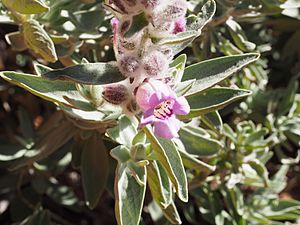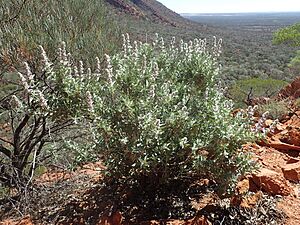Mount Augustus foxglove facts for kids
Quick facts for kids Mt. Augustus foxglove |
|
|---|---|
 |
|
| Pityrodia augustensis leaves and flowers | |
| Conservation status | |
| Scientific classification | |
| Genus: |
Pityrodia
|
| Species: |
augustensis
|
 |
|
| Occurrence data from the ALA | |
The Mount Augustus foxglove (scientific name: Pityrodia augustensis) is a beautiful flowering plant. It belongs to the mint family called Lamiaceae. You can only find this plant in a small part of Western Australia.
This plant is a small, bushy shrub. Its branches, leaves, and even some parts of its flowers are covered in soft, woolly hairs. It looks a bit like other foxglove plants, but its leaves are quite unique.
Contents
What Does the Mount Augustus Foxglove Look Like?
The Mount Augustus foxglove is a bushy shrub. It can grow up to about 1 meter (3 feet) tall. Its branches are covered in thick, greenish-white hairs.
Leaves and Flowers
The leaves grow in pairs along the branches. They are about 3 to 6 centimeters (1 to 2 inches) long. They are also 6 to 15 millimeters (0.2 to 0.6 inches) wide. The leaves have a narrow, oval shape. Both ends of the leaves are wedge-shaped. They are covered in a thick, woolly layer of hairs.
The flowers grow alone or in groups of up to five. They sit on woolly stalks that are 2 to 5 millimeters long. These flower groups can be 5 to 15 centimeters (2 to 6 inches) long. Each flower has woolly bracts (small leaf-like structures) around it.
Flower Colors and Parts
The sepals (outer parts of the flower) are a deep purple-lilac color. They are mostly covered in woolly hairs. They are 9 to 12 millimeters (0.3 to 0.5 inches) long. They form a short tube near their base.
The petals are also a deep lilac color. They form a wide tube that is 18 to 25 millimeters (0.7 to 1 inch) long. This tube has two "lips." The top lip has two small parts, and the bottom lip has three. The outside of the tube has a few hairs. The inside is mostly smooth.
The flower has four stamens (the parts that make pollen). They are usually hidden inside the tube. Two of these stamens are shorter than the others.
When Does it Flower?
The Mount Augustus foxglove flowers from August to October. After flowering, it produces a round fruit. This fruit is surrounded by the sepals.

Where Does the Mount Augustus Foxglove Grow?
This special plant grows on rocky hillsides. You can find it in the Mount Augustus National Park. It also grows on Mount Fraser, which is in the Robinson Ranges. This area is near a town called Meekatharra. These locations are all within the Gascoyne region of Western Australia.
Why is the Mount Augustus Foxglove Important?
The Mount Augustus foxglove is considered "vulnerable." This means it is at risk of becoming extinct. The Australian government lists it as vulnerable under the Environment Protection and Biodiversity Conservation Act 1999. The Department of Environment and Conservation in Western Australia also calls it "Threatened Flora." This means it needs special protection.
Threats to the Plant
There are a few main dangers to this plant. One big threat is animals grazing on it. Another threat, in some areas, is mining activities. People are working to protect this unique plant so it can continue to grow in Western Australia.


